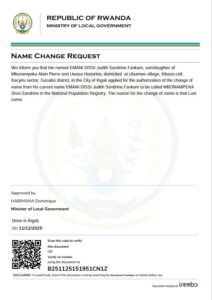
The Ministry of Health has stated that the Marburg virus spreads mainly through direct contact with the bodily fluids of an infected person, which is why the outbreak initially affected healthcare workers, as the first patient was in the intensive care unit and was being treated by doctors.
This viral hemorrhagic fever, caused by the Marburg virus, was first detected in Rwanda on September 27, 2024, in a hospital in Kigali.
On September 29, 2024, the Minister of Health, Dr. Sabin Nsanzimana, informed the media that the transmission method of the Marburg virus is different from other diseases because it spreads through direct contact with an infected person, their bodily fluids, or objects they have used.
He explained that the first patient with the virus was in the ICU at a hospital in Kigali, which led to the infection of several doctors who were caring for the patient.
He said, “This explains why healthcare workers were the first to be infected, as they are constantly in contact with the patient. Even in the ICU, no matter how much you try to protect yourself, there’s always a small risk when you are spending all day trying to restore someone’s health.”
Minister Dr. Nsanzimana also mentioned that after the first patient was identified, testing was conducted on people who had been in contact with the patient, primarily healthcare workers, and some were found to have already contracted the virus.
However, he confirmed that significant progress has been made in tracing contacts and isolating cases, and he is optimistic that the outbreak will soon be contained.
He added, “In most areas, we seem to have identified the root of the outbreak, and therefore we will not impose measures that disrupt everyday life, as that is not the best way to combat Marburg.”
According to data from the Ministry of Health, there are currently 20 confirmed cases of Marburg, with six deaths so far.
Measures being implemented include tracing contacts of confirmed cases and testing them to prevent further spread.
So far, around 300 people who have had contact with infected individuals have been identified and tested, with no new cases being detected.
Health authorities indicate that a person may contract the virus and remain asymptomatic for 3 to 21 days, although in some cases, symptoms appear quickly.
Early symptoms often resemble those of other diseases, particularly malaria, with sudden high fever, severe headaches, joint and muscle pain, and in some cases, gastrointestinal symptoms such as diarrhea and vomiting.
However, as the days go by, the symptoms worsen as the body deteriorates.
Medical experts state that if patients receive early treatment, they may recover, but the mortality rate for those infected ranges from 26% to 89%.
Prevention measures include maintaining strict hygiene and avoiding sharing personal items with someone exhibiting symptoms of the disease.
The entire Rwandan population has been urged to stay vigilant, and anyone showing symptoms is advised to seek medical attention to avoid spreading the virus to others.








